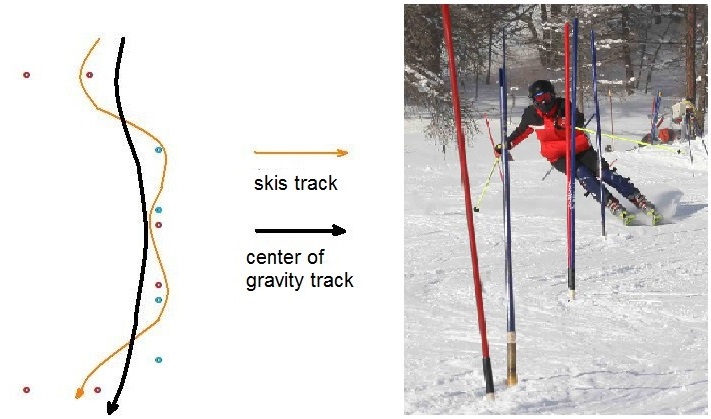Flush passed over from the side, Grange’s hairpin The passage of closed gates in slalom is a struggle with very quickly consecutive poles. A competitor goes past them so fast that they often cannot, and even maintain the smoothness of the ride, should not react to them. I want to draw attention to 2 situations in which the slalom technique tries to make it independent of the mass inertia, to pass the closed gates with the least possible action.
9.1. Flush overrun from the side at a sufficiently high speed
Let’s start with the illustration:

When a racer has to cross a 3 gate flush, usually set aside sideways from the main slalom line, the middle turn in the flush can be made only with the feet and knees so that only the skis pass through the gate. With sufficiently fast travel, the head and torso could remain on the side of the gates line. It requires a certain familiarity from the skier, and the key to implementing this plan seems to be, apart from speed, looking far ahead, “smoothing” the planned route. Needless to say, the smoother the center of gravity track is, the shorter its route and the faster the ride time. This sufficiently far-ahead looking is essential for the rider to take the right position in front of future situations or difficulties. After all, the passage of a closed gate takes only about 0.5 seconds, and in such a short period of time we are unlikely to be able to consciously react to the circumstances.
9.2. Grange’s hairpin
I don’t know what the hairpin crossing method is called in coaching and professional environment. I think it may not have its name, because it is a relatively “young” element of technique, which I observed for the first time in the French slalom master Jean Baptiste Grange ride. As you know, passing the hairpin is very short. At a speed of 40 km/h or 11 m / s, the passing time of a 6-meter closed gate is 0.5 s. Competitors usually pass this system without changing the pole’s hand. They hold the shielding hand until they pass the other pole of the hairpin. Hence the attack of the first pole is by the cross block hand and the second pole by the inner hand. Difficult slalom settings very often force very tight exit from the hairpin gate to fit into the next turn. A great simplification in this situation would be the possibility of attacking the final goal with the crossblock hand, because then it is easier for the competitor to pass the skis close to the pole, and the torso and head have greater freedom of movement. So Grange used a technique in which the first pole of the hairpin is attacked with the inner hand to hold it at the away pole as the cross block hand. It seemed to me that this is a very difficult technique and indeed not all of the world’s top riders use it. It requires planning. To my big surprise, I noticed that young skiers at the regional club level are quite good at it, starting the hairpin system from the trip “on hand” inside. Perhaps the key here is looking far ahead and getting ready for a difficult exit from a short closed gate.